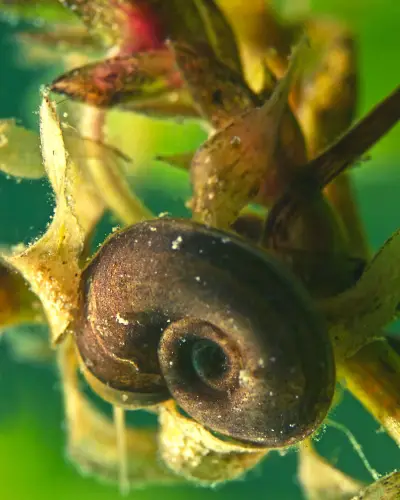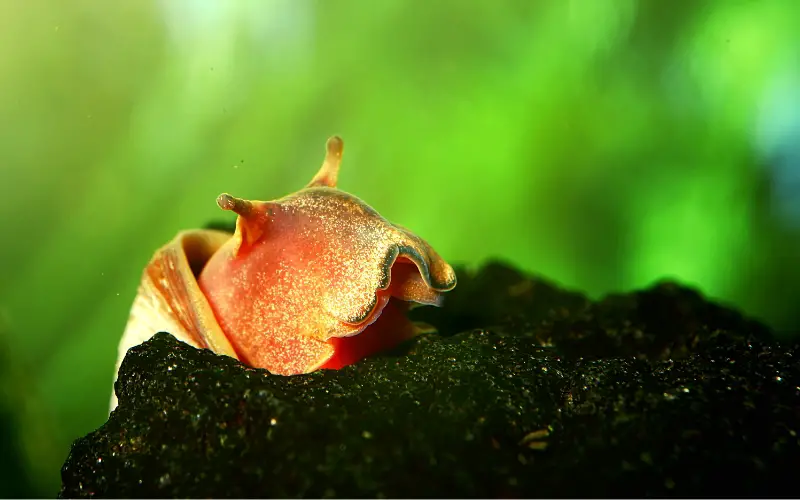Do ramshorn snails eat algae effectively? Ramshorn snails are a popular choice for aquarium enthusiasts looking for a natural way to control algae growth in their planted tanks.
However, there needs to be more clarity surrounding whether or not these tiny creatures eat algae.
In this article, we will delve into the myths and facts surrounding the diet of ramshorn snails and their impact on algae in a planted tank.
Many believe ramshorns are voracious algae eaters, diligently nibbling away at any unsightly growth in the tank.

However, others argue that these snails mainly feed on decaying plant matter and residue rather than actively seeking out algae.
With conflicting information available, it can be difficult for aquarium hobbyists to determine the effectiveness of ramshorn snails in controlling algae.
Join us as we separate fact from fiction and uncover the truth about whether ramshorn snails are genuinely beneficial for algae control in a planted tank.
Table of Contents
ToggleDo Ramshorn Snails Eat Algae in Aquariums?
Ramshorn snails are a type of freshwater snails that are commonly kept in aquariums to help control algae. While they are not the most efficient algae eaters, red ramshorn snails may consume some algae as part of their diet.
These aquatic species have a variety of colors, with the red variety prevalent among aquarium enthusiasts.
In addition to algae, they feed on leftover food, dead or decaying plant matter, and even dead fish. However, it’s important to note that ramshorns may also harm live plants in the aquarium.

One interesting fact about these snails is that they are hermaphroditic, meaning they have both male and female reproductive organs.
Snails can grow rapidly; This makes it easy for them to breed in captivity, leading to a rapidly increasing population if not controlled. Additionally, their shells are translucent and come in various shades of brown, providing a unique aesthetic to the tank.
Will Ramshorn Snails Help Control Blue-Green Algae?
There is conflicting information about whether Ram horn snails will eat blue-green algae (cyanobacteria). Some sources claim they can help control mild outbreaks, while others say they won’t touch it.
Here’s a summary of the different perspectives:
- Ramshorn snails may help control mild outbreaks: Some pet stores and online resources recommend Ramshorn snails to control blue green algae. They argue that the snails will eat the algae, helping to reduce its population.
- Ramshorn snails are unlikely to make a significant impact. However, other sources, including experienced aquarists, believe that Ramshorn snails are unlikely to impact established blue-green algae blooms significantly.
Overall, it is uncertain whether Ramshorns will help control blue-green algae. If you are considering adding them to your aquarium, you must be aware of the limitations and set realistic expectations.
It is important to note that no single solution to removing blue-green algae exists. The best approach typically involves a combination of methods, such as addressing the underlying causes of the outbreak (e.g., reducing nutrients, improving water flow) and using other algae control methods (e.g., manual removal and UV sterilization).
Ramshorn Snails’ Role as Aquarium Pest
Ramshorn snails are commonly found in aquariums and can become a pest if not appropriately controlled. These snails develop into a prolific population because they reproduce quickly.
They particularly enjoy eating dead leaves and decaying plant matter, making them beneficial in a community tank.
However, they can also devour live plants, causing damage to the ecosystem. Ramshorn snails contain calcium in their shells, which makes them popular as a breeder of nerite snails.
Their lifespan varies, but they can live up to a year in ideal conditions. The colors of these snails vary, with black and red being the most common. Ramshorn snails can carry various parasitic flukes that can be transmitted to aquarium fish, threatening the aquarium’s aggressive fish.
One way to control the population of ramshorn snails is to introduce loach or both fish, which enjoy eating these snails. Additionally, crayfish can help eliminate pest snails from the tank.
Regular water changes and removing dead leaves can also help keep their numbers in check. Ramshorn snails reproduce by laying eggs in the substrate, which hatch into tiny snails. The eggs are in a flat coil shape, making them easy to spot and remove if necessary.
These snails particularly enjoy munching on stem plants, which can lead to holes in the leaves and a decrease in the overall aesthetic of the tank.
One unique characteristic of ramshorn snails is their tentacle eyes, which can detect changes in light and movement in the water. They are used to describe their environment and find food sources.
Ramshorn snails enjoy pellet food, which should be given in moderation to avoid overfeeding. They are considered an invasive species in Australia and can outcompete native snails for this great live food. This can lead to a decline in biodiversity in local pond ecosystems.
Ramshorn snails are known to die off if the water parameters are not kept stable, such as fluctuations in hemoglobin levels or pH.
Commonly Asked Questions about Ramshorn Snails Algae Eating (FAQs)
Are Ramshorn snails good at eating algae?
Ram’s horn snails are highly effective at eating algae due to their voracious appetite. They help maintain a clean aquarium environment by actively consuming and controlling algae growth.
What are the cons of Ramshorn snails?
The cons of Ramshorns include their potential to reproduce rapidly, leading to overpopulation. They may also consume live plants or breed excessively, causing an imbalance in the aquarium.
What does the Ramshorn snail eat?
Ramshorn snails primarily eat decaying plant matter, detritus, and algae. They also consume leftover fish food supply and organic debris in the aquarium. Their diet helps clean up the tank, but they may occasionally nibble on live plants.
What are the best snails to eat algae?
The best snails to eat algae include Nerites, Apple snails, mystery snails, and assassin snails. These species are known for their voracious appetite for algae, effectively controlling its growth and keeping aquariums clean and balanced.
Are Ramshorn snails worth it?
Yes, Ramshorn snails are worth considering for your aquarium. They are excellent algae eaters, helping to maintain a clean tank.
Do ramshorn snails eat hair algae?
Yes, Ramshorn snails can help control hair algae. They are not the sole solution, but they graze on various algae, including hair algae, contributing to a cleaner tank.
Do ramshorn snails eat black beard algae?
While Ramshorn snails might graze on young black beard algae, they generally don’t eat mature growths. They can help prevent the algae from spreading but won’t eliminate existing colonies.
Do ramshorn snails eat brown algae?
Yes, Ramshorn snails eat brown algae, making them a helpful part of your aquarium’s cleanup crew. They’ll target brown algae on various surfaces, including aquarium glass and decorations.
What is the best shrimp to eat hair algae?
The Amano shrimp, dwarf shrimp, and red cherry shrimp are the best for eating hair algae. They have a voracious appetite and specifically target various algae types, including hair algae.
Conclusion
In conclusion, ramshorn snails are crucial in maintaining a healthy aquarium ecosystem. These little creatures are fascinating to observe and provide a natural solution to algae overgrowth. With their voracious appetite for algae, they help keep your tank clean and balanced. So, if you’re wondering, “Do ramshorn snails eat algae?” the answer is a resounding yes! Introducing these snails into your aquarium lets you enjoy a beautiful, algae-free environment while giving these fantastic creatures a home. Happy snail-keeping!
You might also like
- Do Mystery Snails Eat Algae: The Truth About Snails & Algae!
- What Do Ramshorn Snails Eat in Aquarium: (Ultimate Guide)
- Do Ramshorn Snails Eat Plants in Aquarium: (Myths & Facts)
- Do Snails Eat Fish Poop in Aquarium: (The Truth Revealed)
- Do Nerite Snails Eat Plants in Aquarium? (The Shocking Fact)
- Ramshorn Snails Pond 101: The Key Player in the Water Ecosystem




